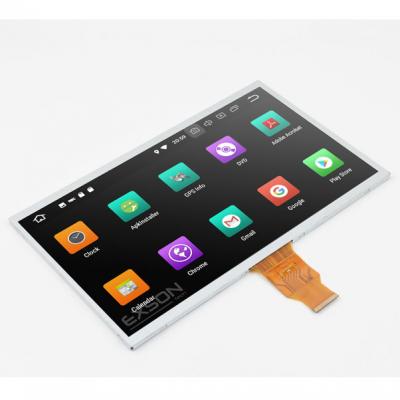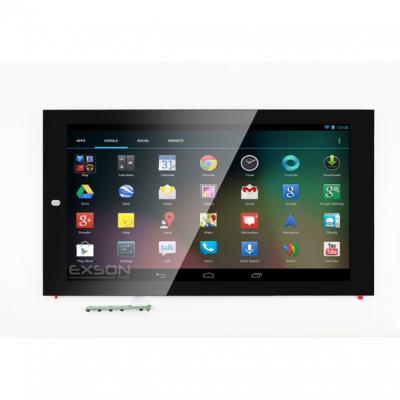There are generally two types of touch screens: capacitive touch screens and resistive touch screens. Next, we will introduce the working principle of resistive touch screens.
Resistive touch screens can be divided into three types in terms of design: 4-wire, 5-wire, and 8-wire. The working principle of each type is similar, and will be briefly introduced below.
Due to factors such as cost and mature technology, 4-wire touch screens are the most basic production specification for almost all touch screen practitioners. In terms of the technology of resistive touch screen, 4-wire touch screens account for more than 50% of the market. Its composition mainly includes an ITO film conductive film and an ITO glass conductive glass, both of which are conductive using a voltage of +5V (some manufacturers use a voltage different from +5V). The spacer is used to separate the ITO film and ITO glass in the middle part of these two conductive layers, in order to avoid short-circuits and misoperations caused by no touch.
The main working principle of the 4-wire resistive touch screen is to regard the lower and upper parts as the Y-axis and X-axis coordinates to work. Two conductive wire circuits are added around the ITO film and ITO Glasss on the four sides of the edge, and a fixed voltage is set at both ends to create a uniform electric field.
Because there is a dot spacer between the upper and lower parts as a barrier, the upper and lower layers are insulated. If the panel is pressed by a pen, finger, or other medium, the two layers will contact and cause a short circuit, resulting in a drop in voltage.
The main composition method of the 5-wire touch screen is basically the same as that of the 4-wire touch screen, that is, the ITO film and ITO glass are divided into upper and lower layers of conductive layers, and they are still conductive using a voltage of +5V after being conductive. The spacer is also used to separate the upper and lower layers. The biggest difference is that the 4-wire touch screen controls two conductive wires for the X-axis and Y-axis respectively, while the 5-wire touch screen controls four wires for the X-axis and Y-axis on the lower conductive layer.
The upper layer is responsible for measuring the voltage pressed on the X-axis and Y-axis, and the voltage value detected by it will be transmitted to the controller, then the coordinates will be obtained, and the digital signal will be transmitted to the host after being converted. Because the upper layer is a uniform conductive layer, any point can be responsible for transmitting the voltage, compared with the 4-wire resistive touch screen, which has high durability, the 5-wire touch screen can maintain consistent accuracy and sensitivity in harsh environments.
Strictly speaking, the 8-wire product is an extension of the 4-wire product, because in order to avoid errors in the voltage reading caused by the environment or other peripheral equipment, in addition to the 4 lead wires for the upper and lower conductive layers, one reference wire is added to each, totaling 8, in order to read more practical voltage values and improve the accuracy of operation.
 Exploring the Technology Behind Medical LCD DisplaysJanuary 25, 2024The advancements in medical technology have significantly transformed healthcare systems, with medical LCD displays playing a crucial role in enhancing patient care. These display panels are specially...view
Exploring the Technology Behind Medical LCD DisplaysJanuary 25, 2024The advancements in medical technology have significantly transformed healthcare systems, with medical LCD displays playing a crucial role in enhancing patient care. These display panels are specially...view Difference Between LCD and TFT ScreenOctober 31, 2022LCD refers to a liquid crystal display, and TFT is a type of LCD. The former is dedicated to desktop computers and the latter is dedicated to notebooks. So, what are the differences between lcd and tf...view
Difference Between LCD and TFT ScreenOctober 31, 2022LCD refers to a liquid crystal display, and TFT is a type of LCD. The former is dedicated to desktop computers and the latter is dedicated to notebooks. So, what are the differences between lcd and tf...view A Complete Guide to the Classification of LCD Liquid Crystal Displays!August 4, 2023Liquid crystal display, abbreviated as LCD, is a matrix display screen driven by thin film transistors. It uses current to stimulate liquid crystal molecules to generate points, lines, and planes, com...view
A Complete Guide to the Classification of LCD Liquid Crystal Displays!August 4, 2023Liquid crystal display, abbreviated as LCD, is a matrix display screen driven by thin film transistors. It uses current to stimulate liquid crystal molecules to generate points, lines, and planes, com...view Exson Tech In-Vehicle LCD Module: Leading a New Chapter in Automotive DisplaysJuly 1, 2024In today's rapidly developing automotive industry, in-car displays have become a key element in enhancing the driving experience and intelligent level. Among many in-car display technologies, LCD ...view
Exson Tech In-Vehicle LCD Module: Leading a New Chapter in Automotive DisplaysJuly 1, 2024In today's rapidly developing automotive industry, in-car displays have become a key element in enhancing the driving experience and intelligent level. Among many in-car display technologies, LCD ...view The Role of Touch Panel Modules in Modern DevicesJanuary 25, 2024In today's fast-paced world, technology plays a vital role in our everyday lives. From smartphones to tablets and even refrigerators, the integration of touch panel modules has revolutionized the ...view
The Role of Touch Panel Modules in Modern DevicesJanuary 25, 2024In today's fast-paced world, technology plays a vital role in our everyday lives. From smartphones to tablets and even refrigerators, the integration of touch panel modules has revolutionized the ...view Illuminating the Display Frontier: An Introduction to TFT LCD TechnologyNovember 17, 2023In the dynamic landscape of visual technology, Thin-Film Transistor Liquid Crystal Display, better known as TFT LCD, emerges as a beacon of innovation, transforming the way we experience digital visua...view
Illuminating the Display Frontier: An Introduction to TFT LCD TechnologyNovember 17, 2023In the dynamic landscape of visual technology, Thin-Film Transistor Liquid Crystal Display, better known as TFT LCD, emerges as a beacon of innovation, transforming the way we experience digital visua...view Call us on:
Call us on:  Email Us:
Email Us:  2F-M1 XiaWei Industrial Park, GuanLan, LongHua District, SZ, China
2F-M1 XiaWei Industrial Park, GuanLan, LongHua District, SZ, China